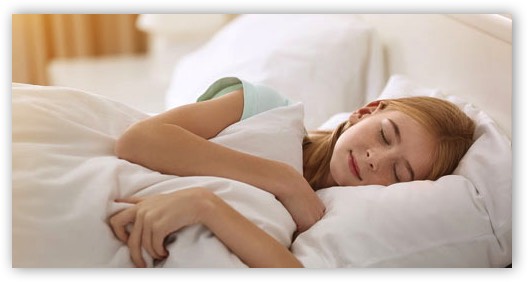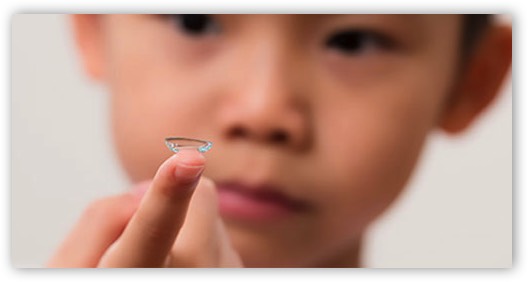
Soft Lenses
MISIGHT 1DAY
NATURALVUE
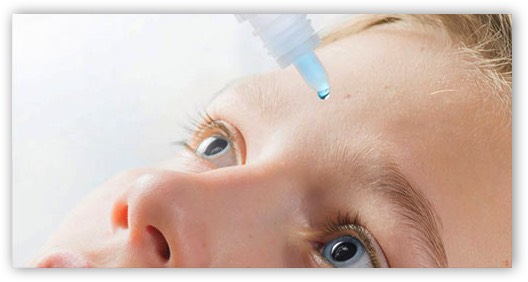
Atropine Drops
Learn About Atropine Drops
LOSE DOSE ATROPINE DROPS
MYOPIA CONTROL
TREATMENT FOR NEARSIGHTEDNESS
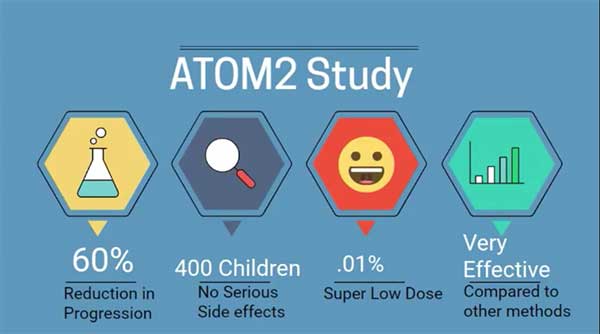
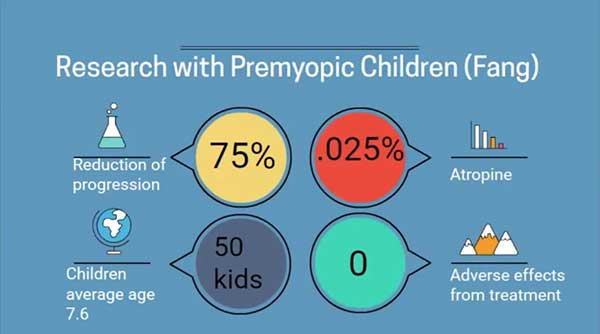
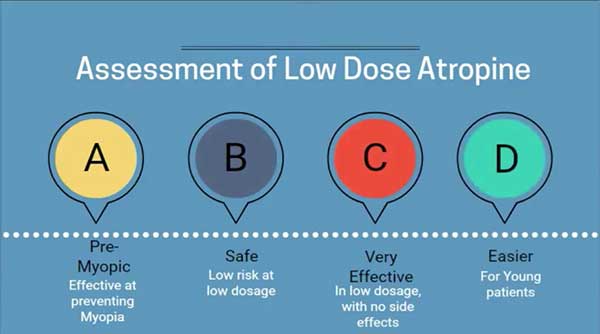
-
Atropine Drops For Controlling MyopiaPrescription atropine eye drops are among the treatment options available to optometrists when managing myopia (nearsightedness) in children.
Atropine has a good safety profile, a low cost per unit, it's easily accessible (available as a generic) and well-tolerated by children. -
How Does Atropine Treat Myopia?Atropine is a non-selective anticholinergic eye drop that works by blocking acetylcholine. Acetycholine has been shown to play a role in the development and regulation of the eyes growth and elongation.
Although the action is not completely known, numerous trials have shown repeatable treatment results with atropine at various dosages. Atropine seems to inhibit the thinning or stretching of the sclera of the eye, resulting in reduced eye growth. -
Are Atropine Eye Drops New in Eye care?Atropine is not a new medication to eye care and has been used close to a hundred years. Atropine has been routinely used by optometrists and ophthalmologists to dilate the eye's pupil to manage pain in acute or chronic inflammations, such as in uveitis. Pain reduction is achieved by the medication's ability to restrict the iris muscle (coloured part of the eye) movements.
Atropine has also been extensively used in children to treat amblyopia, a vision condition that reduces vision in an otherwise healthy eye.- Amblyopia Treatment with Atropine | Atropine eye drops are placed in the 'good eye’, which forces the weaker or amblyopic eye to work harder, thus improving the vision. This is accomplished because atropine dilates the pupil and reduces the near point of focus. The loss of near-point clarity forces the amblyopic eye to work harder to see up close, thus improving the child's visual acuity. This technique is often used when eye patching is either no longer effective or because of cosmetic of functional limitations imposed by wearing an eye patch.
- Amblyopia Treatment with Atropine | Atropine eye drops are placed in the 'good eye’, which forces the weaker or amblyopic eye to work harder, thus improving the vision. This is accomplished because atropine dilates the pupil and reduces the near point of focus. The loss of near-point clarity forces the amblyopic eye to work harder to see up close, thus improving the child's visual acuity. This technique is often used when eye patching is either no longer effective or because of cosmetic of functional limitations imposed by wearing an eye patch.
-
Will Atropine Eye Drops Blur My Child’s Vision?Blurry vision is an unwanted side effect when trying to treat myopia or nearsightedness in school-aged children. As such, atropine eye drops are not prescribed at full strength of 1% like they are in amblyopia treatment or in pain management. Instead, a much-reduced concentration of 0.01%, 0.025%, or 0.05% is used and is why we refer to it as low-dose-atropine therapy.
The concentration of atropine used is based on the child's level of myopia, risk factors, and how well they tolerate the medication. In most cases, we start with the lowest concentration and adjust our treatment strategy over time based on results. -
How Does Atropine Treat Myopia?Atropine is a non-selective anticholinergic eye drop that works by blocking acetylcholine. Acetycholine has been shown to play a role in the development and regulation of the eyes growth and elongation.
Although the action is not completely known, numerous trials have shown repeatable treatment results with atropine at various dosages. Atropine seems to inhibit the thinning or stretching of the sclera of the eye, resulting in reduced eye growth. -
What Are the Common Side Effects of Atropine
Low-Dose atropine eye drops are well tolerated by most children. The drops are compounded in a lubricating eye drop, which further increase the comfort upon insertion and reduces any stinging. Most parents report little problems or discomfort from their children. Atropine is often used in medicine as a medication to help with low heart rate (bradycardia). As such, increased heart rate and flushing of the skin are the two most common side effects with increased dosage levels.
Some of the common side effects of atropine eye drops include:- Dry mouth,
- Blurred vision,
- Sensitivity to light,
- Lack of sweating,
- Dizziness,
- Nausea,
- Loss of balance,
- Hypersensitivity reactions (such as skin rash), and
- Rapid heartbeat (tachycardia)
There is also concern about ‘rebound myopia’ upon discontinuation of the medication. Some children may notice a sudden jump in their nearsightedness and axial length. It’s been proposed that drops should be tapered as opposed to suddenly discontinued, which is the protocol currently being used at eye-bar. - Dry mouth,
-
How Much Does Low-Dose Atropine Cost?
Low-Dose Atropine eye drops are a cost-effective treatment for myopia. As low-dose atropine eye drops are not commercially available, they must be dispensed by a compounding pharmacy. Your regular pharmacy should be able to recommend a location for you or order them in. As low-dose atropine becomes more common, many pharmacy’s have started to keep stock on hand.- The typical cost per bottle is $55-$100
- One bottle normally lasts between 1-3-months (30-90 days) depending on how it’s compounded by the pharmacy. Bottle size is either 5mL (30-days) or 10mL (90-days). This is determined by the compounding pharmacy and the carrier drop they are using.
- Low-dose atropine drops should be discontinued and returned to the pharmacy for appropriate disposable after either 30 or 90-days and a new bottle should be opened.
- Annual cost of treatment is approximately $340-$650
- Drops must be stored in the fridge
- Dosage is usually 1-drop per day.
- Drops are usually compounded using ‘Refresh Tears’ lubricating eye drops as a base. (Active Ingredients Include: Boric acid; calcium chloride; magnesium chloride; potassium chloride; purified water; PURITE® (stabilized oxychloro complex); sodium borate; and sodium chloride. May also contain hydrochloric acid and/or sodium hydroxide to adjust pH.)
- The typical cost per bottle is $55-$100
-
Where Can I Easily Purchase Low-Dose Atropine In Regina?Low cost atropine drops are available directly from our both office locations.
-
What are my Alternatives to Low-Dose Atropine Eye Drops?Low-Dose Atropine eye drops are only one of the options that we use at eye-bar to help treat myopia or nearsighted progression in kids. Alternative options include:
- Lifestyle | Modifications to help delay the onset of myopia
- Eye Drops | Low-Dose Atropine 0.01%
- Eyeglasses | MiyoSmart
- Eyeglasses | Myopilux
- Contact Lenses | MiSight
It’s important to talk with the optometrists about your child’s unique case history, lifestyle requirements, progression history, and personal preferences when selecting a treatment. It’s important to know that we can adjust our treatment option along the way based on results, age, and lifestyle. Consistency in treatment however is crucial to achieving the desired results. - Lifestyle | Modifications to help delay the onset of myopia
-
Our Myopia Control ClinicAt The SpectrumEye Centre, we offer many myopia control options. In addition to myopia controlling spectacle lenses, we also utilize prescription eye drops and soft daily disposable contact lenses. If you're interested in learning more about myopia control for your child's nearsightedness, please book them in for a full eye exam. Saskatchewan Health Care covers children for one complete eye health exam with an optometrist yearly till the age of 18 years old.
Open all Close all
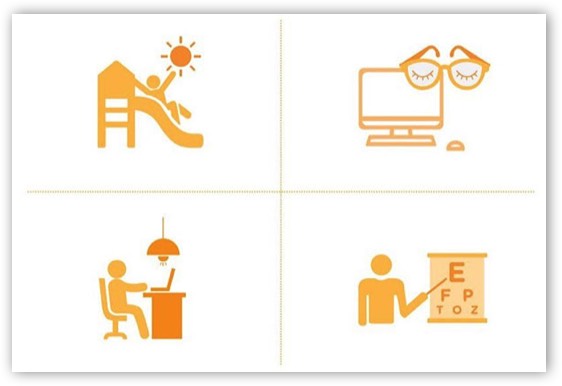
Taking care of eyesight. Wearers should:
- Spend more time outdoors, minimum 2 hours a day.
- Take breaks from long intensive screen time or near-work.
- Take note of ergonomics, such as proper lighting, posture, keeping the recommended working distance are very important to keep your eyes healthy while doing the near-work.
- Get regular eye check-ups to ensure that myopia or other vision problems are detected and treated early, reducing the worsening of vision, myopia progression and potential complications of high myopia.





